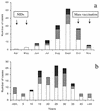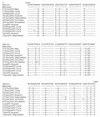Antigenic and molecular characterization of wild type 1 poliovirus causing outbreaks of poliomyelitis in Albania and neighboring countries in 1996
- PMID: 9650935
- PMCID: PMC104951
- DOI: 10.1128/JCM.36.7.1912-1918.1998
Antigenic and molecular characterization of wild type 1 poliovirus causing outbreaks of poliomyelitis in Albania and neighboring countries in 1996
Abstract
Mass vaccination has led poliomyelitis to become a rare disease in a large part of the world, including Western Europe. However, in the past 20 years wild polioviruses imported from countries where polio is endemic have been responsible for outbreaks in otherwise polio-free European countries. We report on the characterization of poliovirus isolates from a large outbreak of poliomyelitis that occurred in Albania in 1996 and that also spread to the neighboring countries of Yugoslavia and Greece. The epidemics involved 145 subjects, mostly young adults, and caused persisting paralysis in 87 individuals and 16 deaths. The agent responsible for the outbreak was isolated from 74 patients and was identified as wild type 1 poliovirus by both immunological and molecular methods. Sequence analysis of the genome demonstrated the involvement of a single virus strain throughout the epidemics, and genotyping analysis showed 95% homology of the strain with a wild type 1 poliovirus strain isolated in Pakistan in 1995. Neutralization assays with both human sera and monoclonal antibodies were performed to analyze the antigenic structure of the epidemic strain, suggesting its peculiar antigenic characteristics. The presented data underline the current risks of outbreaks due to imported wild poliovirus and emphasize the need to improve vaccination efforts and also the need to implement surveillance in countries free of indigenous wild poliovirus.
Figures

 , samples available;
, samples available;
 , samples not available) by month
of onset of paralysis in Albania in 1996. The times of NIDs and mass
vaccination campaigns are indicated. (b) Age distribution of patients
confirmed to have polio and with illness compatible with polio in
Albania in 1996.
, samples not available) by month
of onset of paralysis in Albania in 1996. The times of NIDs and mass
vaccination campaigns are indicated. (b) Age distribution of patients
confirmed to have polio and with illness compatible with polio in
Albania in 1996.


Comment in
-
Outbreak of poliomyelitis in Albania and neighboring countries in 1996.J Clin Microbiol. 1999 Jan;37(1):276. doi: 10.1128/JCM.37.1.276-276.1999. J Clin Microbiol. 1999. PMID: 9988592 Free PMC article. No abstract available.
References
-
- Balanant J, Guillot S, Candrea A, Delpeyroux F, Crainic R. The natural genomic variability of poliovirus analyzed by a restriction fragment length polymorphism assay. Virology. 1991;184:645–654. - PubMed
-
- Bijkerk H. Poliomyelitis in The Netherlands. Dev Biol Stand. 1979;43:195–206. - PubMed
-
- Diamanti E, Ibrahimi B, Dobi V, Dodbiba A. The immunization status against poliomyelitis in Albania, 1986–1990. Bulletin of the University of Tirana, Serial Medical Science. Tirana, Albania: University of Tirana; 1996.
-
- Diamanti, E., B. Ibrahimi, F. Tafaj, E. Mezini, A. Dodbiba, V. Dobi, S. Catone, D. Genovese, P. Simeoni, and L. Fiore. Vaccine, in press. - PubMed
Publication types
MeSH terms
Substances
Associated data
- Actions
- Actions
- Actions
- Actions
- Actions
- Actions
- Actions
- Actions
- Actions
- Actions
- Actions
LinkOut - more resources
Full Text Sources
Medical
Miscellaneous

